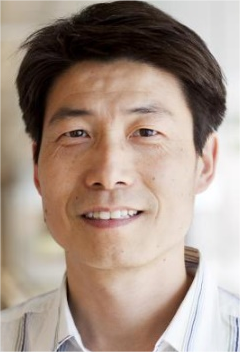 您当前的位置:L. Jay Guo
您当前的位置:L. Jay Guo

Biography:Jay Guo is a Professor of Electrical and Computer Engineering at the University of Michigan, where he joined in 1999 after his PhD and postdoc training. Professor Guo’s lab is involved in interdisciplinary research, with activities ranging from polymer-based photonic devices and sensor applications, flexible transparent conductors, nanophotonics, structural colors and AI assisted design, hybrid photovoltaics and photodetectors, to nanomanufacturing technologies, and are contributed by students from Electrical Engineering and Optics, Macromolecular Science & Engineering, Applied Physics, Physics, and Mechanical Engineering. Prof. Guo has over 280 journal publications; with citation over 30,000 times, and an H-index of 85 (by google scholar). Some notable awards he received from recent years include 2023 Wise-Najafi Prize for Engineering Excellence in the Miniature World from University of Michigan, 2017 William Mong Distinguished Lecturer in Hong Kong University, and 2015 Monroe-Brown Research Excellence Award by the College of Engineering of University of Michigan. His professional service includes Associate Editor of Optica (till 2021); and currently member of the Editorial Advisory Board of Advanced Optical Materials, and Opto-electric Science. His entrepreneur activities include co-founding two startup companies to commercialize technologies from his lab.
Multi-layer thin film based structural colors and transparent electrodes for optoelectronics
L. Jay Guo
Department of Electrical Engineering and Computer Science
The University of Michigan, Ann Arbor, MI, 48109, USA
I will describe recent progress in multi-layer thin film based structural colors, as a more environmentally sustainable solution than the traditional dye-based pigments. Such structures can be mass-produced for commercial applications by physical vapor depositions. However, their Design typically relies on experience, or optimization methods once a structure is known or given. We applied Reinforcement Learning algorithm to treat the multilayer structures as a sequence generation process to design the structures satisfying the targe optical spectrum. As an example, a coating that can mimic the chrome-appearance is designed and fabricated and replace the traditional toxic chrome-plating process. Designs with RF transparency can also be realized, which is not possible with traditional chrome-finishes. Such inverse design problem can also done by a recently developed OptoGPT. Solution deposition techniques were developed to produce simple layered structural colors.
An ultra-thin metal based flexible transparent conductor was developed, for a range of device applications such as touch panels, OLED and PVs. When used as transparent anode for OLED, it addresses a long-standing challenge of light trapping in OLED, limiting the light outcoupling efficiencies. In contrast to the commonly used ITO that has the highest refractive index within the OLED layer stack, thin-Ag based transparent anode can eliminate the waveguide mode, thereby liberating the light that otherwise trapped within the OLED layers. The transparent metal electrode can be advantageously applied to OPV by virtue of its low sheet resistance and adjustable reflectivity; and is also shown as a promising transparent conductor for flexible perovskite PVs.

 沪公网安备 31011402005521号
沪公网安备 31011402005521号